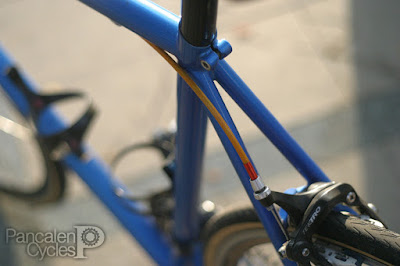On Pias Cycles, we have a thing for steel. It's our material of choice to make our frames: let's face it, it's been with us way longer than any other bicycle-making materials available. I can wax on nostalgic thoughts about it's riding characteristics and stuffs, but to make things short: we just love to ride properly designed steel frames.
Because people are making steel frames for as long as we can remember, a couple things comes to mind. For instance, how can we improve it? Can we incorporate modern features using the humble steel that we all know and love? Can we do that while retaining the proven classic design lines that we all adore?
Enter our fun little project, the Pias Peregrine.
Those questions drives us into developing this frame. After the simple-lined Pias Agra (our first track frame model, we finally named it that) and the ultra versatile Pias Scarab, we wanted to design a road frame of our own. To keep track with our tradition, we pour some twists over the classic and proven look and material.
We began with classic, flat toptubed, squared geometry. Well, not exactly squared: this personal prototype of mine was designed with 53cm seattube (center-to-center) and 54cm toptube (effective). Look it at a glance and you'll think that it's just another skinny-tubed, repainted classic frame. Actually this is what happened to this frame. Not an ideal marketing tool, this is.
One of the intentions of making this frame is to make a mule for our proprietary chainstay design. Got to admit, I made a design flaw on the Scarab: you'll spot dimples on the outer surfaces of the chainstays to make extra room for heel clearance. Not wanting for this to happen again, we developed our own J-bent chainstay mold, and put said chainstays here. Expect this change to be found on our next batch of Scarab.
 |
| I'm a fan of Joe Breeze's work so we put Breezer-styled dropouts here. Looked the part, too. |
The chainstays flows to PressFit 86 bottom bracket shell. Say anything about pressed bottom brackets, but the fact that the extra width compared to conventional threaded bottom bracket shells allows us to set the chainstays further apart, increasing lateral stiffness on the bottom bracket shell area. As for reliability, I've been riding this frame for a year, with SRAM Apex crankset spinning on Token PF86 bottom bracket, with no maintenance issues whatsoever.
Now that we stashed the bottom bracket bearing cup inside the bottom bracket shell, we figured out that stuffing the headset bearing cup inside the headtube will be a good idea. This way, we can spread the toptube and downtube further out, increasing stiffness. We go with 44mm headtube diameter for ZeroStack-styled headset cups, to make maintenance easier. It provides large space to put our headbadge, too. This Redbull can-sized headtube holds a carbon-legged fork with straight 1 1/8" aluminium steerer.
 |
| #slamthatstem #becauseracebikes |
For other details, we'll let these pictures do the talking.
 |
| Just so I didn't forget the name of the guy who designed my frames. Oh, an "n" is missing. |
 |
| This is where I use the light-but-reasonable wheels I wrote a while back. |
We haven't got any plan to produce this frame. Yet. Especially since we're still preparing for the next batch of Scarab.
Oh, by the way. About the name, Peregrine. As a child I've always been fascinated by small falcon birds flying above the rice fields near my home. These birds always soars high, but when they spot their prey they immediately attacked, diving down faster than any animals I've ever seen. These small falcons, also known as peregrines, are recognized as one of the fastest birds on earth.











No comments:
Post a Comment